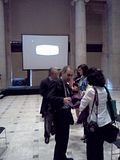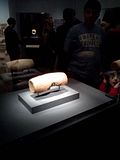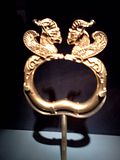 The Asian Art Museum currently has on display the Cyrus Cylinder, a 9-inch cuneiform document from 6th century BC Babylon, on tour from the collection of the British Museum. It's in a small exhibit on the 2nd floor, with 16 additional objects from the reign of the Persian ruler Cyrus the Great. On the show's opening day a couple of weeks ago, I attended the museum's press preview. Museum Director Jerry Xu called the cylinder the 1st human rights declaration & boasted that, as such, San Francisco is an ideal venue for its display. Since Cyrus probably had nothing more or less than conquest on his mind, this might be a rosy interpretation of the cylinder's text.
The Asian Art Museum currently has on display the Cyrus Cylinder, a 9-inch cuneiform document from 6th century BC Babylon, on tour from the collection of the British Museum. It's in a small exhibit on the 2nd floor, with 16 additional objects from the reign of the Persian ruler Cyrus the Great. On the show's opening day a couple of weeks ago, I attended the museum's press preview. Museum Director Jerry Xu called the cylinder the 1st human rights declaration & boasted that, as such, San Francisco is an ideal venue for its display. Since Cyrus probably had nothing more or less than conquest on his mind, this might be a rosy interpretation of the cylinder's text. John Curtis, a representative of the British Museum with the posh title of Keeper of the Middle East Collections, gave a pithy slide lecture on the cylinder. The barrel-shaped object, which Mr. Curtis compared in size to an American football, was buried at the order of Cyrus after he captured Babylon in 539 BC. In it, Cyrus declares himself to have entered Babylon peacefully, & he frees its population from slavery & grants them freedom of religion & freedom to return to their homelands. Jews were presumably beneficiaries of these declarations. The miniscule cuneiform markings read left to right along the length of the cylinder. The object is damaged, a 3rd of it missing.
John Curtis, a representative of the British Museum with the posh title of Keeper of the Middle East Collections, gave a pithy slide lecture on the cylinder. The barrel-shaped object, which Mr. Curtis compared in size to an American football, was buried at the order of Cyrus after he captured Babylon in 539 BC. In it, Cyrus declares himself to have entered Babylon peacefully, & he frees its population from slavery & grants them freedom of religion & freedom to return to their homelands. Jews were presumably beneficiaries of these declarations. The miniscule cuneiform markings read left to right along the length of the cylinder. The object is damaged, a 3rd of it missing. The exhibit's other items include jewelry (armlet pictured), coins, decorative bowls & examples of other writing systems. I'm glad that the show includes 2 cylinder seals. These finely-carved objects the dimensions of a wine cork were used to make impressions on clay to seal containers & documents. Though small, one depicts a charioteer hunting a lion. No mention was made that morning of the entertaining story from Herodotus of how Cyrus's army manged to march into Babylon by surprise.
The exhibit's other items include jewelry (armlet pictured), coins, decorative bowls & examples of other writing systems. I'm glad that the show includes 2 cylinder seals. These finely-carved objects the dimensions of a wine cork were used to make impressions on clay to seal containers & documents. Though small, one depicts a charioteer hunting a lion. No mention was made that morning of the entertaining story from Herodotus of how Cyrus's army manged to march into Babylon by surprise.§ The Cyrus Cylinder And Ancient Persia: A New Beginning
The Asian Art Museum
Aug. 9–Sept. 22, 2013
No comments:
Post a Comment